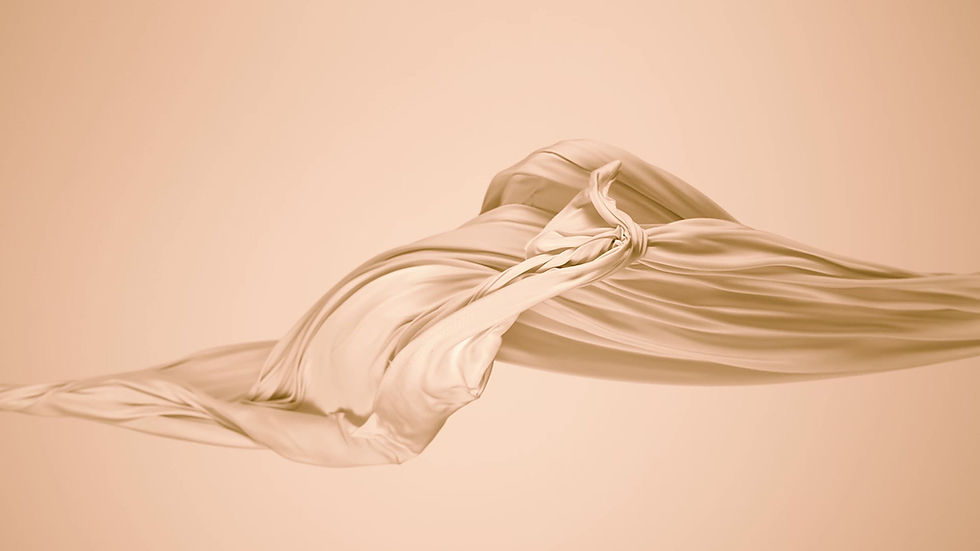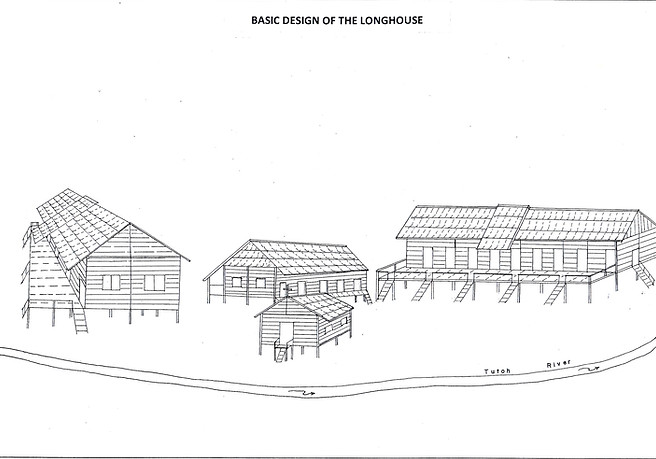
Kayan Language Legacy Project
LANGUAGE, CULTURE, AND IDENTITY



Long Panai circa 1970's Uma Dipah drawn by Diang Jok (2014)
ASEN | ORIGIN
Asen tam Kayan nih men Usun Apo (Apau), daleh Kalimantan, Indonesia. Bi usi tam jam hiran lan lan sepun tam nih ney men inan avin usi te' en daha' ngalung. Kayan nih usi tam asen aleng te' ngalung men itam, lung-lung men daha' sepun tam tua nah aleng itam jam. Daha' dekaya' menuna' na lung nunih, bi usi pah daha' nan men itih, avin uh kuri-kuri tebin nah aleng te' ha' Sarawak anih. Avin itam em te' kalung menuna' jadi usi nah itam nuno' jam marung nuno' tam bulak ney ha' daleh Sarawak nih. Aleng kitan tam marung gaya' tam bulak iha' nah men lung-lung daha' sepun tam menuna' dahin peleken alem tekná. Kurin leken daha' tih, Kayan nih ney bulak ha' hinih avin kahum na'an tuk kah: ilo tana avan na luma, tulah ji'ek, dahin te' pah avin daha' perang te' hang daha'.
Kurin Rousseau, ji lake' anthropologist aleng murip te' hang daha' Kayan menuna', kuma anih peng tam Kayan aleng ney men Kalimantan menuna': Uma Aging, Uma Apan, Uma Baho, Uma Baluy Jile, Uma Baluy Lepu’e, Uma Baluy Long Liko, Uma Baluy Ukap, Uma Bawang, Uma Belun (Belor), Uma Beluvu, Uma Daro, Uma Depe’, Uma Hawei, Uma Hiban, Uma Juman, Uma Kahai, Uma Kelejo, Uma Laren, Uma Leken, Uma Lesong, Uma Levuring, Uma Luhat, Uma Nyaving, Uma Pagong, Uma Pako’, Uma Pau, Uma Pliau, Uma San, Uma Sang, Uma Semuka, Uma Suling, and Uma Tapo’ (Rousseau, 1990).
Deng kah ala katah daha' Kayan Uma Beluvuh, nuno tuk daha' bulak ney ha' Sarawak. Dalo Kayan men Uma Beluvuh nih dih ney bahji daleh Tutoh hinih daha'. Kahum kah luvung daha' menuna ha' alem Tutoh nih, bi kerey nih ha' Lung Paney hinih nah uma Kayan Uma Beluvu (Beluvuh) nih te' kere' nih. Dalo' dep kah Kayan alem Tutoh nih. Kahum kah tebin tam Kayan ha' alem Telang Usan, ha Baram urey lahuh ha' Belaga dahin Tubo.
The Kayan people of Sarawak are originally from Usun Apo (also known as Apau) in Kalimantan, Indonesia. The exact timing of their migration to Sarawak is unknown. As an oral society, there are no written records that can pinpoint the specific time or circumstances of their early movements from their ancestral homeland. Elders of the current generation recall stories passed down from their parents and grandparents about a place in Usun Apo where their ancestors once lived. However, most have no personal memory of the place, knowing it only through these oral narratives.
According to Rousseau (1990), the Kayan who migrated to Sarawak were from different local groups. Rousseau, an anthropologist who lived amongst the Kayan in the early 70s were privileged to have recorded stories from the Kayan elders who listed the groups to include Uma Aging, Uma Apan, Uma Baho, Uma Baluy Jile, Uma Baluy Lepu’e, Uma Baluy Long Liko, Uma Baluy Ukap, Uma Bawang, Uma Belun (Belor), Uma Beluvu, Uma Daro, Uma Depe’, Uma Hawei, Uma Hiban, Uma Juman, Uma Kahai, Uma Kelejo, Uma Laren, Uma Leken, Uma Lesong, Uma Levuring, Uma Luhat, Uma Nyaving, Uma Pagong, Uma Pako’, Uma Pau, Uma Pliau, Uma San, Uma Sang, Uma Semuka, Uma Suling, and Uma Tapo’ (Rousseau, 1990).
The migration patterns of the Kayan people can be partly understood through the case of the Kayan Uma Beluvuh in Long (Lung) Panai. Notably, this is the only Kayan longhouse located along the Tutoh River in Baram. In contrast, most Kayan settlements are found along the Baram River itself, as well as in the regions of Belaga and Tubo.
As an oral society, the Kayan have no written records of their history. Much of what is known about them comes from oral traditions and their narrative song-tales, known as tekná. In the absence of documentation, very little is known about the rich and colorful history of the Kayan, including the reasons behind their migration from their ancestral homeland, or daleh, in Kalimantan. According to oral histories passed down through generations, their migrations were driven by various factors, including the need to find new land for farming, the appearance of bad omens that required them to leave a place, and, in some cases, disputes between longhouses or tribes (Wan et al., 2018).
Migration
The Kayan migrated in groups, often moving collectively as longhouse communities from one location to another along their migratory routes. It has been suggested that, due to their tendency to remain within their own group, the Uma Beluvuh Kayan were able to preserve their distinct language variant. Another contributing factor is geographical isolation: their remote location along a tributary of the Tutoh River has limited their interaction with other Kayan communities. As a result, there has been minimal contact with speakers of Kayan Uma Pu which is the more dominant variant spoken in longhouses along the Apoh River and Upper Baram.
Dahun Kayan nih iha' nah dahun tam Kayan alem Sarawak. Kurin daha' aleng jam, dahun Kayan nih iha' nah men asen na' Malayo-Polynesian, iha' tih asen dahun Austronesian kurin daha'. Te' kuri-kuri na'an dahun tam Kayan nih, awi dahun dalo aleng te' ha' Kalimantan; Lebu' Kuit, Mboh Pua', Uma Leken, Kayan Bahau, Kwang Tring, dahin Kayan Uma Belor. Dahun daha' Kayan ha' Baram iha nah: Kayan Uma Pu, Uma Peliau dahin Uma Leken.
Kayan Uma Beluvuh early migration
Kahum kah na'an lung marung nuno' tam Kayan nih bulak. Tengu tam Kayan nih ney bulak ha' Sarawak kurin daha', ha' daleh Rejang hitih tam te'. Bi te' nah bale' men daha' ngenep nah daha' tey pasan ha' Baram, ngejeloh unge' Baram. Dalo Kayan pu'un Uma Beluvuh nih dih, bulak ha' Tutoh dalo.
Ha' Uma Usun Apo dalo Uma Beluvuh anih na luvung una'. Lake' Anyie Lirung dawa' Lake' Belare' Luhat aleng geri daha'. Kurin lung, legak nah Belare' nih alem unge' jadi en na' ngehawa' nah ji baya'. Kurin lung tih, mina' baya' aleng te' ha' Baram nan dih kira baya' Belare' anan lo ken daha'. Bulak pah daha' la'an tey ha' Nahah Kuleh, kira' men duman 1864-1880. Tutek lan daha' pasan, ateng daha' na uma ha' avan daha' kere' nih ha' Lung Paney.
The story of the Kayan Uma Beluvuh journey of migration varies. This is not unusual for oral history. It was told that sometime in the early nineteenth century, the Kayan in Apo Kayan (Kayan plateau) Kalimantan begun their journey from the Apo Kayan towards the far reaches of the Rejang River in Northeastern Borneo. A smaller breakaway group known as Kayan Uma Beluvuh made their way toward the Baram River. This group of Kayan moved several times along the Baram, finally making their way along the Tutoh River, a tributary of the Baram River. Today, their settlement is in Lung Panai, a remote settlement located some 200km away from the nearest town Marudi.
According to the oral histories of Kayan elders, the first settlement of the Kayan Uma Beluvuh in the Baram was at Uma Apo. The group was led by two leaders, Anyie Lirung and Belare’ Luhat. There is a fascinating piece of folklore that tells the story of Belare’. According to the tale, Belare’ fell into a river and was taken by crocodiles. It is said that he married a crocodile and lived among them. Did he become a crocodile himself? No one knows. Legend has it that the crocodiles living in the Baram today may be his descendants.
The Kayan Uma Beluvuh later migrated to Nahah Kuleh. According to stories told by the elders, and based on the counting of harvest seasons, this settlement period is estimated to have lasted from 1864 to 1880. After leaving Nahah Kuleh, the group moved several times before settling in their current location at Lung Panai (Anyie, 1995).
Kayan Lung Panai early movements
Avan daha' bulak menuna (Anyie, 1995)
Location (Baram) Date
Usun Apo (Apau) unknown
Nahah Kuleh 1864 – 1880
Bato Halo' 1880 – 1890
Location (Tutoh)
Lung Win 1890 – 1898
Lung Tebesuk 1898 – 1908
Lung Bawang 1908 – 1928
Lung Apoh 1928 – 1949
Lung Bah 1949 – 1975
Lung Panai [Paney] 1975 - current
References
1. Anyie, R. L. (1995). The trail of the Kayan Uma Beluvuh. The Sarawak Gazette, CXXII(1532), 16- 20.
2. Rousseau, J. (1990). Central Borneo: Ethnic identity and social life in a stratified society. Oxford: Clarendon Press.
3. Wan, R., Renganathan, S., & Kral, I. (2018). Tekna - a vanishing oral tradition among the Kayan people
of Sarawak, Malaysian Borneo. Indonesia and the Malay World, 46(135), 218-234.

Visitors are encouraged to explore the website for more information about the Kayan, their language, and culture.
